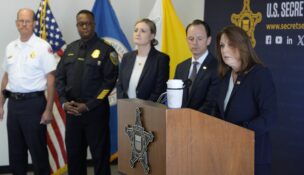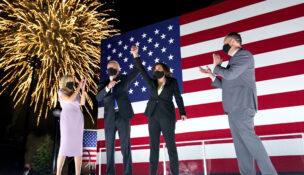Racial disparities task force divided on ‘use of force’ definition
By: Michaela Paukner, [email protected]//April 20, 2021//
Racial disparities task force divided on ‘use of force’ definition
By: Michaela Paukner, [email protected]//April 20, 2021//
A state task force assessing racial disparities engaged in a heated debate on Tuesday over whether to use the word “proportionality” in a recommended definition of the use of force.
A subcommittee of the Speaker’s Task Force on Racial Disparities held a public meeting to discuss defining the use of force in state statute. The meeting was one of the group’s discussions before it submits a report with 17 recommendations on racial disparities and police policies in Wisconsin.
Lawmakers, community advocates and law enforcement spent much of Tuesday’s three-hour discussion on whether to include the word “proportionality” in the recommended definition of the use of force.
Sheriff Kalvin Barrett, who serves Dane County and works as a law-enforcement instructor at Madison College, explained how officers are taught to use force in proportion to the threat they encounter. He said force should be proportionate to an individual’s behavior, and officers should constantly assess any given situation to decide whether to use more or less force.
Jim Palmer, executive director of the Wisconsin Professional Police Association, and Steven Roux, Rice Lake police chief, thought adding “proportional” to the definition made it too subjective. They were concerned it would prevent officers from acting when they should, putting law enforcement and the public in danger.
“Our communities expect our officers to act,” Roux said. “If all of the sudden we add confusion where an officer doesn’t know if they have justification for a proportional level of force and they don’t act, I just don’t think the outcome is what our communities are going to expect.”
Palmer introduced his own language that he believed clarified how officers should determine when to use force.
“Listening to the discussion from our last meeting and hearing the concerns, I was trying to be thoughtful about that and come up with some specific criteria to help identify and inform the public and an officer when use of force is appropriate,” Palmer said.
Barrett thought Palmer’s definition encompassed the majority of what the group wanted to respond to concerns from law enforcement and the public.
Fred Royal, president of the Milwaukee NAACP, brought forward language for consideration from the New Jersey attorney general that uses proportionality in its definition. Royal said including the word would make law enforcement more accountable for their decisions.
“Proportional force would allow a district attorney to consider a lesser threshold before they brought charges,” Royal said.
ReBecca Burrell, a community activist, and Wayne Strong, a retired lieutenant of the Madison Police Department, agreed. They said they see a lot of subjectivity used in applying objective reasonableness to police-brutality cases and that different standards are often applied to communities of color.
“The language is important, but we also need to look at the facts of what’s happening every day,” Strong said.
Rep. Jim Steineke, R-Kaukauna and committee chair, said the group’s goal is to add transparency and accountability through consensus.
“Even if it is not the perfect wording, in my opinion, it’s better than not having anything in state statute,” Steineke said.
“But don’t you think America is past the point of it’s better than having anything?” Burrell asked. “We just witnessed a man being killed on every screen, and we are going through a trial that’s traumatic to my community … We need to address a major issue with a major solution.”
Rep. Shelia Stubbs, D-Madison and committee chair, acknowledged that it was a difficult time for communities of color. She said she was willing to start from scratch if what had been brought before the group wasn’t working.
“What you’re hearing at this table is a cry out from communities of color that enough is enough,” Stubbs said. “We are in a unique position where we can craft what works for us in Wisconsin.”
Stubbs suggested forming a work group to continue to work on the language of the definition. Several of the members from the task force expressed interest in doing so. Steineke said the report would explain that the group came to a consensus that a statewide definition was needed but was still working on the language.
The subcommittee plans to submit a report with 17 recommendations for legislation. The group has been meeting since September to discuss a number of issues, including no-knock search warrants and data collection. Follow @WLJReporter
Legal News
- Milwaukee County District Attorney, UWM police address Jewish threats
- With GOP convention over, Milwaukee weighs the benefits of hosting political rivals
- Secret Service head resigns as Congress formally investigates
- Milwaukee Police Department issues statement regarding video release policy
- GOP convention sets the stage for the Democratic convention in Chicago, activists and police say
- Survey: Harris has enough delegates to be nominee
- Outside the RNC, small Milwaukee businesses and their regulars tried to salvage a sluggish week
- Biden called to resign immediately after the president announces he won’t seek reelection
- Biden drops out of 2024 presidential race, endorses Harris
- Local PA cops allegedly thought Trump’s would-be assassin was Secret Service
- Biden-Lead Secret Service admits agency denied past requests by Trump’s campaign for tighter security
- Class action filed against Walgreens
Case Digests
- Ineffective Assistance of Counsel; Double Jeopardy; Sentencing
- Ineffective Assistance of Counsel; Sexual Assault-Prosecutorial Misconduct
- Contract-Negligence
- Criminal Law; Juvenile Law; Discovery
- Family Law; Child Support; Property Division First paragraph(s)
- Ineffective Assistance of Counsel- Exclusion of Evidence of Witness Bias
- Postconviction Relief-Sentencing-Ineffective Assistance of Counsel
- 14th Amendment – Due Process
- Criminal-Sentencing Guidelines – Enhancement
- Bankruptcy-Tax
- Civil Rights – 14th Amendment-Jury Instructions
- Contract; Foreclosure and Property











